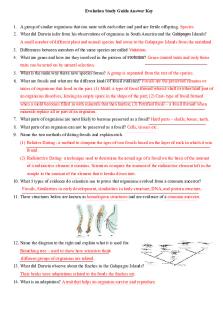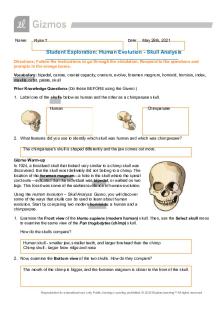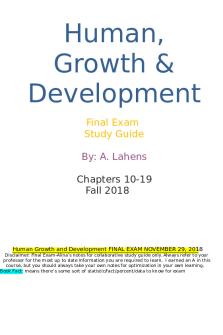Human Evolution Final Study Guide PDF

| Title | Human Evolution Final Study Guide |
|---|---|
| Course | Introduction To Human Evolution |
| Institution | Washington University in St. Louis |
| Pages | 17 |
| File Size | 462.7 KB |
| File Type | |
| Total Downloads | 72 |
| Total Views | 153 |
Summary
Comprehensive notes on the lectures and readings from Introduction to Human Evolution taught by Professor David Strait. Serves as a study guide for the final exam....
Description
Key Fossils ● Engis 2 ○ Discovered 1829 at Engis cave in Belgium ○ First human fossil discovered ○ Oddly-shaped → long ○ Neanderthal baby ● Gibraltar 1 ○ Discovered 1848 at Forbes Quarry ○ Neanderthal skull ○ Discovery predates that of the neanderthal type specimen ● Feldhofer 1 ○ Discovered in 1856 in the Neander valley ○ Homo neanderthalensis ○ Long, low cranium and receding brow ● Trinil 2 ○ Discovered in 1891 at the Solo River in Java ○ Eugene Dubois wanted to test the idea that orangutans were the closest relatives of humans ○ Homo erectus but originally thought to be Pithecanthropus erectus by Dubois ○ Long, with a flat forehead and distinct brow ridges ● Eoanthropus dawsoni ○ Discovered at Piltdown in 1912 in England by Charles Dawson ○ Widely accepted as evidence of evolution’s missing link (false) ○ Large brain, ape-like jaw ● Taung ○ Discovered in 1924 at the Buxton Quarry by Raymond Dart ○ Juvenile - 3 years old when died ○ Not an ape or monkey ○ Well-preserved fossilized imprint of neurocranial cavity ○ Swelling on bottom is the cerebellum and we can thus infer that the spinal cord must have exited the skull through the cranium ○ Must have been bipedal and therefore human ○ Small canine and non-projecting face is humanlike ○ Small brain is chimp-size and not humanlike ○ Australopithecus africanus ● KNM-ER 1470 ○ Homo habilis discovered in 1972 at Koobi Fora, Kenya ● Australopithecus afarensis ○ Key discovery in 1973 at Hadar, Ethiopia
○ Partial skeleton (Lucy) ○ Small-brained hominin with big teeth but bipedal ■ Confirmed that bipedalism evolved first
History of Human Evolution ● 1809: Lamarck articulates his first fully formed hypothesis of human evolution ● 1858: Charles Darwin and Alfred Russel Wallace write their paper on evolution ● Thomas H. Huxley: fierce advocate for Darwin ○ Creates structure for modern biology department ○ Gives talks ○ One of which is an analysis of Feldhofer 1 in which he concludes that it is not “the missing link” evolutionarily ● Robert Broom: senior paleontologist from South Africa, studied reptilian ancestors of mammals ○ Discovers other South African Australopithecines that establish there are other early humans besides the Piltdown skull ○ Piltdown skull discovered to be a forgery ● The Descent of Man: 1871 book by Charles Darwin in which he hypothesized that bipedalism was related to tool use in terms of evolution because it freed hands to use tools ○ Essentially, once humans started using tools, the evolution of the precision grip, larger brain, and evolution of language evolved too ○ This hypothesis is wrong, however, because if it were true you would expect these adaptations to all evolve at the same time and they did not ■ The earliest hominins pre-date the earliest tools by 4.5 million years
Context of Human Evolution ● Relative increase of cercopithecoids and decline of hominoids in the Miocene ● Naturally occurring climatic changes were external pressures for selection ○ Tectonic events are a source of climate change ● During the Cretaceous period, North America and Europe were close ● The connection between the Arctic and Pacific Oceans has been closing over the last 15 million years ● Water in the Arctic ocean gets trapped there and an overall cooling trend is related to this ● The world also gets drier
● A cooling trend in the Plio-Pleistocene coincides with increased climatic variability ○ The overall cooling temperature drops the overall temperature down to a threshold which creates cascading effects ● A key tectonic event was the raising of Central America ● Periodic advance and retreat of the glaciers ● Oxygen isotope stages ○ Odd numbered stages are warm ○ Even numbered stages are cold ○ Stage 2 is the last glacial maximum ○ Stage 5 is the last interglacial maximum ● Vegetation also changes over tens of thousands of years ○ Periodic expansion/reduction of vegetation is a serious selection pressure but usually mainly reduction ○ Megafauna used to exist in Europe
What Makes Us Human? ● Large brain ○ Slight increase 3 million years ago ○ 2 million years ago is when it takes off ● Tool use ○ 2.6 million years ago/3.5 million years ago ● Precision grip ○ 2 million years ago ○ Long thumb ○ Broad apical tuffs ○ Flexor pollicis longus ● Language ○ Very complicated trait ○ Evidence doesn’t preserve well ○ Younger than 2 million years ago ● Bipedalism ○ Earliest evidence 7 million years ago ○ No question that it evolved first → defines humans ○ Initially evolved and set us apart from other apes ● Functional morphology of bipedalism ○ Valgus knee joint ■ Knee joint closer together than hip joint ■ Shaft and plane have acute angle between them ○ Hip musculature
■ In gorillas, the ilium is oriented so that the flat part faces forward ■ In humans, the pelvis is bowl-shaped and the ilium faces to the side ■ The lesser gluteal muscles (gluteus medius, gluteus minimus) pass behind the hip joint in gorillas, so their thigh extends when they contract their muscles ■ In humans, because the ilium is rotated, the muscles pass in front of the hip joint so an abduction motion is made when contracting ■ Crucial to bipedalism ○ Large, adducted hallux ■ Your big toe is in line with other toes ■ 80% of your weight is put on your big toe when you walk so it needs to be stable and not mobile as well as large ● Hypotheses of evolution ○ Charles Darwin’s about bipedalism/tool use (see The Descent of Man term up above) ○ Carrying ■ Difficult to test ■ Multitasking, evolution of monogamy, sexual monorphism are related to carrying (load-carrying, child carrying) ○ Thermoregulation ■ We have the ability to sweat to maintain body temperature and bipedalism allows more of the body to be exposed to wind
■ ■ False because no early hominins were found in shady habitats so no need for thermoregulation ○ Feeding posture ■ Standing upright is associated with feeding behavior thus feeding posture hypothesis suggests bipedalism evolved for it and THEN ancestors started walking ■ Presumes that hominins ate a lot of fruit that grew on trees ■ This is compatible evidence that is not fully provable ○ Locomotor efficiency
■ Travelling between food trees, a hominin could not run out of energy ■ This hypothesis thus states that bipedalism evolved because it required less energy than quadrupedal knuckle-walking ○ Vertical climbing ■ When forests disappeared and hominins did not climb on trees anymore, they were pre-accustomed to walking bipedally, so they did ■ Testable
Important Excavation Locations ● Zhoukoudian, China ○ Cave system in Beijing ○ Excavated between 1923-1937 ○ Yielded one of the first species of Homo erectus, called Peking Man ● Olduvai Gorge, Tanzania ○ Excavated 1929-present ○ Odd rocks discovered and are thought to be the earliest evidence of stone tools ■ Oldowan tools ○ Lewis & Mary Leakey ○ 1959 - OH5: Zinjanthropus boisei was discovered and thought to be the toolmaker ○ 1964 - OH7: Homo habilis was discovered and known to be the toolmaker ○ First human fossil to be dated using radiometric methods, specifically potassium-argon dating ● Koobi Fora, Kenya ○ Paranthropus boisei ○ Homo habilis ○ Homo erectus ● Turkana Basin, East Africa ○ Provided archaeological evidence of the first stone tools ○ Controversial because only a few tools are in the right sediments ○ Paranthropus boisei ● Dikika, Ethiopia ○ One bone, shaft of bovid limb with small marks ■ Sharp, angular marks characteristic of stone tool cut marks (earliest?) ● Atapuerca, Spain ○ Network of caves ○ Bodies tossed down a hole ○ Found skull ■ Entire middle of face projects forward
●
●
●
●
■ Mandible has gap between last molar and ascending ramus, probably no functional purpose ■ Large nose ■ Double arching of brow ridges ■ Differ slightly from Homo heidelbergensis but have shared, derived characteristics with neanderthals Jebel Irhoud, Morocco ○ ~300 kyr ○ Compare with recent modern human, neanderthal → similar cranial shape to neanderthals Skhul, Israel ○ ~120 kyr ○ Odd, large, projecting brow ridge Qafzeh, Israel ○ ~80 kyr ○ People found that look fully modern, but record is not great Arene Candide, Italy ○ ~28 kyr ○ Hat made of perforated shells
Human Evolution - Major Hominin Groups
Name
Key Species
Age
Region
Size
Activity Pattern
Locomotio n
Diet
Social Organi zation
Key facts
Preaustralopith
Sahelanthropus tchadensis, Ardipithecus ramidus
MiocenePliocene (~7-4.2 mya)
East Africa, NorthCentral Africa
Large (30-60 kg)
Diurnal
“Facultative” terrestrial bipedalism? (able to move on two legs even though they didn’t have many of the adaptations of bipedalism) Arboreal “climbing”?
Frugivore with leaves
?
Earliest known hominins Lived in wooded or savannah-woodland mosaic habitats Small brain (370-400 cc), like apes Small molars + premolars, thin enamel, like apes Somewhat reduced facial projection, foramen magnum (hole on bottom of skull) facing inferiorly (sign of bipedalism), and canine slightly smaller/less projecting → all synapomorphies with
other hominins “Gracile” australopiths
Australopithecu s afarensis, Australopithecu s africanus
Pliocene → early Pleistocen e (4.2-2.0 myr)
Eastern Africa, Southern, NorthCentral Africa
Large (30-60 kg)
Diurnal
Terrestrial bipedalism, some arboreal suspension/c limbing
Frugivory with leaves or nuts/seeds, possibly supplement ed with meat or tubers. Diet probably included mechanicall y resistant (hard or tough) foods
Polygyny ?
Australopithecus africanus first australopith species discovered Lived in wooded/savannah-woo dland mosaic habitats Brain slightly larger than apes synapomorphy with later hominins Large molars and premolars with blunt cusps and thick enamel, thick jaws, further reduced canines Many traits indicating terrestrial bipedalism (synapomorphies with later hominins), although unlike bipedalism in modern humans Possibly used stone tools Several traits indicating arboreal behaviors Considerable sexual dimorphism in body size, although modest dimorphism in canine size
Robust Australopiths
Paranthropus boisei, Paranthropus robustus
Latest Pliocene Early Pleistocen e - 2.7 1.4 myr
Eastern, Southern Africa
Large (30-60 kg)
Diurnal
Terrestrial bipedalism? Other? → bad evidence of terrestrial bipedalism
Uncertain nuts/seeds and tubers are possibilities but can’t rule out fruits and leaves Diet def. Included mechanicall y resistant foods
Polygyny
Lived in more open grassy habitats, some wet and some dry Sagittal crest, inflated zygomatics = massive chewing muscles Brain slightly larger than apes (400-550cc) Massive, thick mandible, massive molars and premolars, hyper-thick tooth enamel, indicating hard foods? Very small canines and incisors (synapomorphy with later hominins) High sexual dimorphism in body size, but not in canine size Descended from gracile australopiths
Early Homo
Homo habilis
Latest
Eastern,
Large
Diurnal
Terrestrial
Possibly an
?
Lived in mosaic habitats
Pliocene → Early Pleistocen e (2.8-1.4 myr)
Southern Africa
(30-50? kg)
bipedalism and some arboreal climbing/sus pension
omnivore, probably some meat
as environments became cooler and drier Brain size larger than gracile australopiths (510-750cc); smaller molars, premolars and mandibles than australopiths although much larger than ours; less projecting face than australopiths; precision grip thus presumed tool maker → all these are synapomorphies with later Homo Possibly more than one species Long upper limb → potentially arboreal? Presumed ancestor of later Homo, likely descended from gracile australopiths Earliest Homo found at Ledi-Guraru, which used to be a mosaic → specimen LD 350-1
Archaic Homo
Homo erectus, Homo heidelbergensis, Homo neanderthalensi s Other species: Homo naledi, Homo floresiensis
Pleistocen e (1.9 myr-40 kyr)
Africa, Asia, Europe
Large (~45-~75 kg)
Diurnal
Terrestrial bipedalism
Omnivore including meat
?? May include monoga my
Recognizably human Large brain (650-1700cc) increases over time; larger body size; robust but otherwise nearly modern postcranial skeleton; reduced molars, premolars, mandibles with less projecting faces → all synapomorphies with modern humans Later populations show reduced sexual dimorphism Increasingly sophisticated stone tools Later populations have controlled use of fire Ecologically flexible; first hominins to leave Africa Later populations buried or systematically disposed of their dead
Modern Homo
Homo sapiens
Middle Pleistocen
Initially Africa,
Large (~45-~13
Diurnal
Terrestrial bipedalism
Omnivore including
Most often
Large brain (1,200-1,600 cc)
e → now (~300 kyr - today)
then global
0 kg)
meat
monoga mous
Tall, rounded cranium, widest superiorly Small, flat face, small teeth and jaws, chin Reduced, divided brow ridge Tall, “lanky” body proportions but variation Technologically sophisticated Behaviorally and ecologically flexible, colonizes world Art, symbolism, and modern language
Key Species of Major Hominin Groups
Name
Hominin Group
Age
Discovery site Key specimen Qualities
Sahelanthropus tchadensis
Preaustralopith
Miocene ~7myr
Toros Menalla in Chad, a geological basin in North Central Africa
T M 266, a cranium that was badly fractured but usable
Humanlike qualities such as a reduced facial projection but small brain
Ardipithecus ramidus
Preaustralopith
Pliocene - 4.2 myr
Middle Awash/Aramis site, Ethiopia
“Ardi” - partial skeleton specimen ARA-VP 61500 from Aramis
Diet info present, suspected to be folivorous Small canines, some facial projection (like chimpanzee) Evidence of bipedalism is not strong, uncertain if valgus knee joint is present Abducted big toe means big toe was grasping, which was not a bipedal feature but rather apelike
Australopithecus afarensis
Gracile Australopith
Pliocene 3.9-2.95 myr
Hadar, Ethiopia Laetoli, Tanzania
“Selam” - partial skeleton, juvenile specimen DIK-1-1 from Dikika “Lucy” - partial skeleton specimen AL-288-1 from Hadar
Valgus knee joint present Cranially oriented scapula Long, curved phalanges
Australopithecus africanus
Gracile Australopith
Pliocene - Early Pleistocene - 3-2 myr
Sterkfontein, South Africa
“Little Foot” partial skeleton, Specimen Stw 578 from Sterkfontein
Brain a little larger than chimpanzees
Paranthropus boisei
Robust australopith
Pleistocene 2.3-1.4 myr
Olduvai Gorge, Turkana Basin, Koobi Fora
Paranthropus robustus
Robust australopith
Pleistocene 1.9-1.5 myr
Drimolen, Swartkrans, Kromdraai
Homo habilis
Early Homo
Latest Pliocene Pleistocene, 2.8-1.4 myr
Olduvai Gorge, Koobi Fora
Homo erectus
Archaic Homo
Early-middle Pleistocene: 1.9 myr-200 kyr
Trinil, Java, Indonesia Zhoukoudian, China Koobi Fora Dmanisi, Georgia
KNM-WT 15000 - youth fossil, almost a modern skeleton, has characteristics of bipedalism which is the first time we can definitively say this
Reasonably fast spread around the globe Acheulian tools used Evidence of advanced social behavior → an individual was found with lost teeth and a bone had been fixed, showing the individual lived for long enough with no teeth because they had gotten assistance from members of their group
Homo heidelbergensis
Archaic Homo
Middle Pleistocene 600-200 kyr
Mauer, Germany Petralona, Greece Dali, China Kabwe, Zambia Bodo, Ethiopia
Mauer mandible discovered in 1907 Petralona more vertical forehead than Homo erectus Trinil specimen
Brain size slightly larger than Homo erectus (1150-1250 cc) Overall cranium more rounded Morphology shows up all over the world Europe: 500-300 kya Africa: 600-250 kya Asia: 500-200 kya Homo erectus still lived in Indonesia by the time Homo heidelbergensis had colonized the world
Homo floresiensis
Archaic Homo
Liang Bua, Flores,
LB1 - partial skeleton & skull
Very small →...
Similar Free PDFs

Human Evolution Final Study Guide
- 17 Pages

Evolution study guide 2
- 3 Pages

Evolution Exam 1 Study Guide
- 11 Pages

Evolution Study Guide Answer key
- 2 Pages

Human Cognicion Evolution
- 97 Pages

Human Evolution Gizmo - Ryan
- 8 Pages

Gizmo: Human Evolution
- 9 Pages

Study Guide - Final Exam Guide
- 21 Pages

Final Exam Study Guide- final
- 3 Pages

Marketing Final Study Guide
- 92 Pages

Final Study Guide NR509
- 22 Pages

CS61b final study guide
- 18 Pages

Final Exam study guide
- 40 Pages
Popular Institutions
- Tinajero National High School - Annex
- Politeknik Caltex Riau
- Yokohama City University
- SGT University
- University of Al-Qadisiyah
- Divine Word College of Vigan
- Techniek College Rotterdam
- Universidade de Santiago
- Universiti Teknologi MARA Cawangan Johor Kampus Pasir Gudang
- Poltekkes Kemenkes Yogyakarta
- Baguio City National High School
- Colegio san marcos
- preparatoria uno
- Centro de Bachillerato Tecnológico Industrial y de Servicios No. 107
- Dalian Maritime University
- Quang Trung Secondary School
- Colegio Tecnológico en Informática
- Corporación Regional de Educación Superior
- Grupo CEDVA
- Dar Al Uloom University
- Centro de Estudios Preuniversitarios de la Universidad Nacional de Ingeniería
- 上智大学
- Aakash International School, Nuna Majara
- San Felipe Neri Catholic School
- Kang Chiao International School - New Taipei City
- Misamis Occidental National High School
- Institución Educativa Escuela Normal Juan Ladrilleros
- Kolehiyo ng Pantukan
- Batanes State College
- Instituto Continental
- Sekolah Menengah Kejuruan Kesehatan Kaltara (Tarakan)
- Colegio de La Inmaculada Concepcion - Cebu


